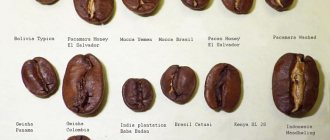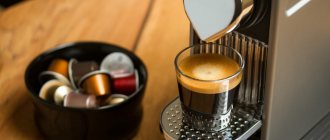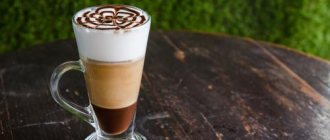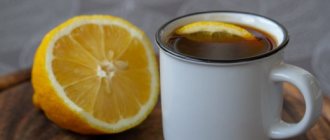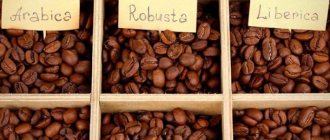More than 80 countries grow coffee trees. Coffee varieties are classified according to different parameters: the quality and type of beans, the type of processing of the fruit or the degree of roasting. Arabica grows on 75% of the plantations, the remaining fields are occupied by robusta. South America remains the leader in coffee bean exports, with Asia and Europe taking second and third places.
Coffee is one of the most invigorating and aromatic drinks.
The world's main suppliers of coffee products
In 2021, more than 130 million bags of coffee (60 kg each) were harvested in 50 coffee-producing countries. The main suppliers of products were the following countries (million bags):
- Brazil (35.5);
- Vietnam (27.9);
- Colombia (13.5);
- Indonesia (8.3);
- Honduras (7.1).
Brazil is the main supplier of coffee.
Ethiopia is among the world's top ten largest exporters, with a market share of 4% (up to 4 million bags).
Most of the Arabica coffee here grows in the wild. The most elite varieties of coffee are Sidamo, Harar and Yirgacheffe.
Rare varieties of coffee beans
The lion's share of the entire coffee industry is built on the production of Robusta and Arabica. But there are several more bright varieties of coffee that are worthy of gourmet attention. For example: Excelsa, Liberica or Maragogype.
Excelsa
An extremely rare type of coffee bean. Grows in central Africa and Asian countries (Vietnam, Philippines, Indonesia)
The peculiarity of this variety is its fruity and nutty aroma with a slight sourness in taste.
The drink goes well with spicy spices. Ideal for espresso, French press and Turk. To obtain a delicate, multi-faceted taste, Excelsa is mixed with Arabica, and for lovers of strong coffee, Robusta is also added.
Many elite varieties of coffee are made from excelsa. The most famous of them is Colombian. Its taste is soft, but at the same time rich in taste.
Maragogyp
This variety is grown in Guatemala, Colombia, Nicaragua and Mexico. The taste of the grains is distinguished by astringency and viscosity. The drink is thick and rich, with a pleasant aftertaste of nuts, fruits and chocolate.
Maragogyp is very picky when growing. Grain, like a sponge, absorbs all the smells and aromas of the environment in which it is located. Therefore, an important criterion for obtaining a high-quality drink is the growth of raw materials in a favorable environmental environment, for example in the mountains.
Liberica
One of the fewest (only 1%) types of coffee on earth. Liberica enjoys a warm and moderately humid climate. During periods of drought, the tree simply stops bearing fruit, so it usually grows in India, the Philippines and Malaysia. Moreover, in the latter, the production of this variety is carried out on a huge scale and occupies up to 95% of the territory of local plantations. Malaysians do not recognize any other coffee than Liberica.
A special feature of this variety is its unusual aroma. It is comparable only to the fragrance of Indian flowers. At the same time, it perfectly repels insects.
Kopi Luwak
This variety differs from its predecessors not only in the extremely high price of the finished grain, but also in the unique way it is processed.
An important step in the process of making Kopi Luwak is the digestion of the grain in the stomach of the musang. This animal looks very similar to a badger.
Musang collects and eats only the largest and ripest grains. But in his stomach, coffee is not completely digested, but is released along with a valuable enzyme naturally. The grain is then washed, dried and roasted. The quality of the harvest depends on the season.
Black Ivory
Elephants are directly involved in the creation of this elite type of coffee. They consume the ripest Arabica berries, then fermentation occurs in the stomach. Certain acids remove bitterness from grains and give them unique notes reminiscent of fruit. The naturally obtained product is washed, dried and fried.
Chon
In the process of obtaining this coffee, the producer uses martens. In the digestion of these animals, grains are also not completely absorbed and are excreted in feces. In general, the processing and pre-sale preparation of coffee is similar to Kopi Luwak.
Interestingly, these cute animals were previously considered pests, but today they are specially raised in designated areas.
Starbucks
The most popular type of coffee in the USA. Bred and sold exclusively by the global giant of the coffee industry of the same name. It has a bright aroma, rich taste of spices and sourness.
Coffee Yauco Selecto
A rare variety of Caribbean Arabica, with a memorable, pleasant taste. There are more than 90 species of coffee plants, but the most popular are Arabica and Robusta.
Blue mountain
Elite variety of Jamaican coffee beans. It is appreciated by consumers for its soft but rich taste without bitterness.
Coffee classification
Coffee is classified by type of tree, type and hardness of beans, processing method, country of origin, degree of roasting. Marks that indicate these parameters are always placed on product packaging.
By type of coffee tree
There are the following main types of coffee trees:
- Arabica. Its homeland is Ethiopia. Trees with red or red-violet fruits grow up to 5 m. Highlands (900-2100 m above sea level) are suitable for plantations. The light brown grains are shaped like an oval, up to 1.5 cm long. Arabica does not tolerate cold well and is susceptible to disease.
- Robusta. Congolese coffee can be distinguished from Arabica coffee by photographs. Trees that reach 10 m in height are grown at altitudes of up to 900 m. The beans are round in shape with a dark red shell.
- Liberica. On tall trees (up to 20 m), oval fruits up to 2.5 cm long appear. Due to its weak taste, it is not of great industrial value.
Arabica is the most popular type of coffee.
Arabica has a sweetish taste. Robusta is characterized by bitterness due to its high caffeine content (2.7%).
By type of coffee beans
There are large, medium, and small grains in size, but different countries have their own labeling. Indonesian manufacturers use the letters L, M, S. In Africa they mark AAA (large), AA (medium), AB (small). Depending on the hardness of the grains, the following markings are accepted:
- SHB - Arabica of the highest degree of hardness, growing at an altitude of 1400 m above sea level;
- HB - hard grains from plantations at an altitude of 1200-1400 m;
- MHB - fruits with medium hardness, growing on the plain;
- LGA is a soft bean used for low-quality coffee.
Elite Arabica coffee has the highest hardness.
According to the method of processing coffee beans
After harvesting, the fruits are subjected to dry or wet processing. In the first case, the grains are washed and left to dry for 3 weeks. They are then peeled and winnowed to remove any remaining skin. Wet processing involves placing the grains in water for 24 hours. Primary fermentation of the fruits occurs, so they become softer. After washing, the grains are cleaned using machines.
Coffee beans vary in how they are processed.
By grain quality
Labeling varies from region to region. The letters A, B, C are often used, which correspond to high, medium and low quality. Some manufacturers have the following designation:
- AA - the best variety;
- AB - good;
- BA - average quality coffee;
- BB is a low quality product.
EP (European preparation) means that up to 8 defects have been removed from 300 g of coffee.
AP (American) involves removing up to 23 defects from a similar quantity of goods.
By degree of freshness
There are 2 types of coffee beans. New crop means packaging immediately after harvesting and processing, old crop means last year's harvest. The mature label is placed on coffee that has been stored in a warehouse for 1 to 3 years. For more mature varieties (6-10 years), the designation vintage/aged coffee is used.
Coffee beans can be from last year's harvest or fresh.
By strength
The strength is influenced by the variety, grinding, roasting and brewing method. The following types of strong coffee are distinguished depending on the caffeine concentration (mg/ml):
- espresso - 2;
- in Turkish - 0.8;
- filter coffee - 0.6;
- Americano, cappuccino - 0.4.
Sometimes the strongest is called ristretto - black coffee prepared in a coffee machine.
This drink has a richer taste due to the presence of essential oils, but contains less caffeine than espresso.
By degree of roasting
Depending on the intensity of heat treatment, there are the following degrees of roasting:
- Easy. The process lasts until the first click. The grains become dry and acquire a light brown color.
- Average. The beans turn out darker.
- Strong. The grains become dark brown and caramelize.
- Highest degree. The fruits are glossy due to the essential oil and acquire a black-brown color.
The grains have different intensities of heat treatment.
Light processing is suitable for high-mountain varieties with a loose structure. Strong coffee is used to make coffee from Cuba, Guatemala, and Africa.
By country of production
South American varieties have a mild flavor with medium intensity. Grains from Ethiopia, Burundi, Zambia, and Uganda are famous for their strength. Congo grows Robusta with a tart flavor, while Kenyan Arabica has a mild aftertaste.
There are classical Arabica plantations in Yemen. Robusta with a pronounced sweet aroma is common in Vietnam.
What are coffee beans
Coffee beans are not beans at all - they are the seeds of the berries of the coffee tree. These are the botanical tricks. The berries of the plant are located in the axils of the leaves, have an oval or spherical shape and a diameter of 1-1.5 cm. They are covered with a dark red or black peel, under which there is pulp and two paired grains covered with a shell.
Coffee contains fats (12%), proteins (13%), sugar (8%), caffeine (0.65-2.7%), potassium, magnesium, calcium, iron and 12 trace elements. When roasting, as a result of chemical reactions, the proportion of sugar is reduced to 3%, and fats, nitrogenous substances and caffeine are increased.
Each type has a specific benefit; some varieties consist of a mixture of grains and can be flavored.
Coffee beans are not beans at all - they are the seeds of the coffee tree berries.
Natural grains contain furans, pyrazines, pyrols, and aldehydes—volatile compounds that stimulate taste buds. Therefore, we perceive caramel or honey notes, fruity or herbal aromas in the drink. All compounds are formed during coffee growing and processing, and are fully revealed only after roasting and preparation.
Rating of coffee producers
The list of the largest producers of beans and ground coffee includes the following companies:
- Lavazza.
- Paulig.
- Kimbo.
- Malongo.
Lavazza is an Italian coffee company.
Jardin coffee is popular. The company sources Arabica from Kenya, Ethiopia, Indonesia, Colombia, and Guatemala.
Maragogype
One of the most recognizable varieties, Maragogype, is a mutation of Typica; first developed in Brazil. It is notable for its unusually large grain size and is therefore very popular. Maragojipa trees are characterized by unusually large leaves and relatively low yields. Due to its impressive size, this coffee is often called “elephant bean”. Ripe fruits are usually red.
The best coffees
South America, Ethiopia and Yemen are considered to be the producers of the best products. Most plantations are located at an altitude of 1000 m above sea level, so the grains receive an unusual taste and rich aroma.
Brazilian Bourbon Santos
It received its name in honor of the island of the same name in the Caribbean Sea. For him, the first 3 crops are collected from the trees. The coffee turns out buttery and sour. The drink has a rich taste with a nutty-chocolate aroma and notes of orange.
Brazilian Bourbon Santos is one of the best coffees.
Maragogyp
A distinctive feature is large grains, which are 3.5 times larger than standard Arabica. This drink has a complex taste: spicy with an admixture of wood, wild berries, nougat, and flowers. There is always sourness, the aroma includes tobacco notes.
Medellin
The Colombian variety grows at an altitude of 1800 m above sea level. The beans are lightly roasted to preserve the soft wine-fruit sourness with a caramel aftertaste. The description of the smell is dominated by a light nutty aroma.
Medellin - Colombian coffee of the highest quality.
Colombia Excelso
Coffee plantations are located at an altitude of 900-1800 m in the Cordillera mountains. Columbia Excelso beans are medium in size, have a dense structure with light fruity sourness and sweetness. The aroma includes citrus or nutty notes.
Maracaibo
The photo of this Venezuelan variety shows the main difference from other types - yellow grains. Maracaibo, with a slight taste of dry white wine, grows in the states of Trujillo, Tachira, and Merida. The low quality of the raw materials is compensated by the grape aroma.
Maracaibo is one of the highest quality and delicious varieties of coffee.
Costa Rica
This coffee is considered elite. It has a spicy aroma and high strength. It has a multifaceted taste: cocoa is combined with fruit, vanilla, and honey notes.
Decaf
Decaffeinated coffee is made by treating green beans with solvent, steam, activated carbon or liquid carbon dioxide. This drink is more sour and soft compared to the others. In Russia, decaf has blue or green packaging, while abroad it is orange.
Decaf is produced by extracting caffeine from coffee beans.
Supremo
For this type of coffee, the highest quality beans with a length of more than 7 mm are selected. The variety is grown on the northern slopes of the Cordillera in Colombia. There is almost no acid in it, but the chocolate tastes good. The aftertaste contains apple and almond notes.
Dalat
This Arabica variety grows in the central part of Vietnam at an altitude of 1400-1600 m above sea level. Dalat is a strong coffee with fruity, caramel, and nutty undertones. The aroma includes notes of rosehip, lemongrass, and orange.
Dalat is a Vietnamese Arabica from a highland plantation.
Altura
Coffee beans are grown in the Sierra Maestra region of Cuba at an altitude of 600-800 m. The variety has little acid, but is strong. The drink is famous for its bitterness, which is combined with a tobacco flavor. The aroma is sweet, tart with an almond-caramel undertone.
Antigua
Elite coffee from Guatemala has a dense texture with slight sourness and sweetness. When characterizing Antigua, attention is paid to the thick, spicy aroma with notes of smoke. The drink smells of cocoa, prunes, and fruit.
Antigua is an unusual spicy coffee.
Oksaka
The plantations are located in the southern states of Mexico. The Oksaka variety is distinguished by its light consistency, slight bitterness, and delicate aroma. Depending on the degree of roasting, the flavors of caramel, maple syrup, vanilla or hazelnut appear.
Antigua and Cobano
While the Antigua variety is characterized by the aroma of fruit and prunes, Cobano coffee from Guatemala is characterized by light floral notes. It is strong with a slight sourness and has a rich nutty taste. Grains are more expensive due to difficult care.
Kobano was named after the city where it is now grown.
El Salvador Chalatenango
Arabica grows on the Los Plains plain (altitude more than 1500 m above sea level). The drink of this variety has a thick structure with sweetness. At first you notice almonds, later a floral aftertaste appears.
Ethiopia Sidamo Mocha
Premium coffee plantations are located on the plateau of Sidamo Province (southwest Ethiopia). The drink has a velvety texture with rich fruity sourness. The taste reveals dark chocolate, nuts, cinnamon, cardamom. The aftertaste is reminiscent of jasmine. The aroma is dominated by chocolate and wine notes with an admixture of blackberries and apples.
Ethiopia Sidamo Mocha - forest grains.
Yemen Mocha
Yemeni coffee is grown in highland plantations (above 1000 m above sea level). With strong roasting, the flavor of cocoa with spices appears, with weak roasting - citrus. The aroma is dominated by fruit notes.
Dependence of taste on variety
The taste of a coffee drink primarily depends on the type of coffee bean. But not only. It also depends on the region, conditions and method of cultivation, type and quality of processing, fermentation, roasting, storage conditions and preparation of the drink. The variety determines only the main characteristics of the product and the potential of the future drink.
The best coffee is grown in the mountains.
At low altitudes, the fruits ripen faster in the sun, but the grains acquire a very soft, almost bland taste. In the mountains the situation is different. The berries ripen more slowly, overcoming weather conditions, enduring heat and cold, getting wet in the rain, and blown by the winds. As a result, the grains become denser, acquire a richer taste, and accumulate organic acids.
Coffee can have different acidity levels. The latter depends on the height of plant growth and processing methods. The sour taste can be like that of a green apple, orange, currant, etc. We can feel these notes in the drink. Moreover, it is the complex composition of sensations that is highly valued.
The richer the bouquet, the more interesting the taste and aroma become, the more positive emotions we get from tasting. If there is little acid, then the coffee is grown on the plain.
The acidity of coffee depends on the altitude of the plants.
Roasting allows you to maximize all the natural characteristics of the grains and extract from them a whole bouquet of flavor and aromatic compounds. For this, only fresh raw materials are used, which is why it is so important to know the time of harvest and export. There are several types and profiles of roasting.
The traditional method involves preparing coffee in a specific way for different drinks. For espresso or ristretto, this is usually a dark roast; for alternative options (French press, drip coffee maker, pour over, Aeropress) it is light. The latter is becoming increasingly popular, since the beans do not lose anything at high temperatures, and all their notes and aromas are taken with them into the cup.
For a quality product, only this method is used to reveal all the characteristics inherent in nature. Light roast is completely unsuitable for espresso. This needs to be taken into account when purchasing.
Elite coffees
The elite list includes the following species:
- Jamaica Blue Mountain. It combines notes of tobacco, caramel, pepper, and flowers.
- Old Java. The grains are stored in bags for 2 to 6 years to obtain a rich taste and aroma.
- Kopi Luwak. A special feature of the production is the fermentation of beans in the Luwak stomach.
- Kenya Ruiruiru (Kenya AA Ruiruiru). The drink has a cherry flavor with a tobacco aftertaste.
- Yellow bourbon. Brazilian grains give a taste of chocolate, peanuts, almonds, and the aftertaste is tobacco with earthy notes.
Jamaica Blue Mountain is a Jamaican subspecies of coffee.
The premium class includes the soft Australian Skyberry and the exotic Ecuador Vilcabamba.
Pacamara
The variety was obtained by crossing Pacas and Maragojipa in 1958 in El Salvador. Like Maragojipe, it is distinguished by very large leaves, fruits and coffee beans. The Pacamara variety also has very pronounced taste characteristics, which experts highly appreciate. The taste of such coffee can be chocolate and fruity, but sometimes it can also be unpleasantly grassy, with an onion flavor. The fruits turn red when ripe.
Coffee drink recipes
Coffee beans of varying degrees of roasting are mixed with milk, alcohol, cold water, honey, and spices. The result is new types of drinks.
Espresso
The strong drink was invented in Italy at the beginning of the 20th century. For classic espresso you will need 2 ingredients:
- 7 g medium ground coffee;
- 30 ml cold water.
Espresso is a method of preparing coffee by passing hot water through a filter.
The drink is prepared in a coffee machine or manually using a Turk. In the latter case, the raw material must be filled with water and placed on medium heat.
You must wait until foam appears. In a coffee machine, water is passed through the beans for 25 seconds.
Romano
This is espresso with the addition of lemon juice. For 30 ml of drink - 5 ml of fresh lemon juice. You can use the zest for decoration.
Ristretto
The drink is considered a subtype of espresso, but differs from the latter in its smaller volume and amount of caffeine. It contains the following ingredients:
- 7 g freshly ground coffee;
- 15 ml water.
Ristretto is one of the ways to prepare black coffee.
Ristretto is prepared only in a coffee machine. Coffee is poured into the holder horn and pressed with tempera. Then turn on the water flow for 20 seconds. A dense foam of uniform brown color forms on the surface.
Mocha
Classic mocha consists of the following components:
- 1 tsp coffee beans;
- 50 mg dark chocolate;
- 50 ml milk (3.2% fat).
You need to brew espresso. Melt the chocolate on the stove and pour it into a tall glass. Then add warmed milk and coffee. Top with whipped cream.
Latte
The peculiarity of the drink is the foam up to 1 cm thick. According to the classic recipe, frothed milk (180 ml) is poured into coffee (50 - 60 ml). For lattes, medium or finely ground beans are used.
Latte is a coffee drink originating from Italy.
Macchiato
The picture shows the distinctive feature of a macchiato - fluffy foam. To prepare the drink, whisk 15 ml of chilled milk. It is then poured in a thin stream into a shot of espresso. You can add sugar, caramel syrup, cinnamon.
Cappuccino
The Italian drink is a mixture of a double portion of black coffee (60 ml) with the same amount of milk. First, beat it with a cappuccino maker until it doubles in size and carefully add it to the invigorating drink, holding the foam.
Cappuccino is a mixture of espresso and foamed milk.
Viennese coffee
The traditional recipe includes the following ingredients:
- 30 g ground coffee;
- 225 ml water;
- 115 ml milk.
Prepare espresso in a Turk and leave to cool for 10 minutes. The milk is heated to 70 °C, whipped with a mixer until thick foam is obtained. Mix with coffee. Foam is added on top.
Irish
Alcohol is an essential part of this drink. It includes the following components:
- 80 ml black coffee;
- 30 ml whipped cream (20-30% fat);
- 40 ml Irish whiskey (Baileys liqueur);
- 1 tsp Sahara.
Irish is a cocktail consisting of hot coffee, whiskey and sugar.
The drink is poured into a tall glass with a handle. Sugar and warm alcohol are added to the liquid. Gently add whipped cream in a thin stream.
Americano
When preparing it, a portion of espresso (30 ml) is diluted with hot water (from 90 to 400 ml) in a large glass. This drink is weak due to the low concentration of caffeine. Fine or medium grind grains are suitable for Americano.
Frappe
The frappe requires the following ingredients:
- 1-2 tsp each instant coffee and sugar;
- 100 ml cold water;
- ice cubes.
Frappe - coffee with foam, whipped with ice.
Mix coffee with sugar in a container, pour 2 tbsp. water. Shake everything with a shaker. Place ice at the bottom of the glass and pour the finished coffee foam on top. Then add the rest of the water.
Glyase
To prepare the drink you will need 150 ml of coffee and 50 g of ice cream, which is placed on top. The use of rum, cognac or other alcohol is allowed. You can add vanilla, cinnamon, grated chocolate.
Honey raf
The drink recipe includes the following components:
- 50 ml black coffee;
- 100 ml cream (15% fat);
- 1 tsp light honey.
Honey raf is a whipped mixture of coffee and cream.
Dissolve the remaining elements in the brewed coffee. Whisk the resulting mixture and pour into a glass goblet. Sprinkle cinnamon on top.
Torre
An Italian cocktail is prepared with 30 ml of milk and 150 ml of coffee. The first component is whipped until a dense foam is obtained. Sugar is added to the finished coffee and poured into a tall glass. Place milk foam on top and sprinkle with cinnamon.
Similarities and differences between drinks
The basis of coffee drinks is usually espresso. However, they differ from each other in the method of preparation and additional ingredients. For example, latte, cappuccino and macchiato are prepared using the same ingredients, but there are differences between them. Recipes imply different procedures.
In a latte, the first layer is milk, followed by espresso and milk foam. Coffee is initially added to cappuccino. Then add warm milk, which is covered with foam. A macchiato uses only espresso and frothed milk.
Even regular black coffee will be called differently depending on the volume and the presence of additional components. The standard portion of a drink (30 ml) prepared in a coffee machine is espresso. If you reduce the amount of water a little, it will be ristretto, and if you add lemon juice, it will be romano.
Additional questions and answers
About 1.6 billion cups of the invigorating drink are consumed around the world every day. Therefore, it is useful to know a few interesting facts about coffee.
How new varieties of coffee appear
To obtain new coffee trees, two methods are used - cuttings and planting seeds. In the first case, you can cross 2 species to get a hybrid. Cuttings take root quickly, so they can bear fruit in the first season after planting. The seeds take 6 weeks to germinate. With the second method, you need to wait about 5-6 years to get the first harvest.
New varieties of coffee appear through planting seeds.
How many types of coffee are there?
From 2 to 3 thousand varieties are cultivated in the world. Most of them are located in Ethiopia, where some of the trees grow in the wild. Only about 12 varieties are grown in other regions.
What is the most popular type of coffee
The most common is Bourbon Santos from Brazil. Residents of North and South America and Scandinavia drink weak Americano or mochaccino. Muslims make black coffee with spices. Asians love coffee cocktails with ice cream and fruit. The Greeks prefer frappe, the Italians prefer Romano. Western Europe loves espresso.
Bourbon Santos is the most common coffee variety.
What type of coffee is the strongest?
Robusta has a higher strength because it contains a lot of caffeine. The mixture called Death Wish Coffee consists of beans brought from Indonesia and Vietnam. The alkaloid content is 1.5-2 times higher than normal.
What is the most expensive type of coffee
Black Ivory (Thailand) is considered the most expensive. The entire small harvest is exported, so for 1 kg they ask for $1000. A cup of drink costs at least $50. A special feature of the production is the fermentation of grains in the stomach of elephants.
Features of Arabica
Arabica was the first type of coffee that people were introduced to. Until the 18th century, only one type of coffee was known - Typica. But in the 18th century, Arabica was brought to South America. On the fertile lands of the Antilles, Typica began to mutate.
One of the first varieties bred in the New World is Bourbon, whose yield is approximately 20–30% higher than Typica. In the 19th century, the Scots were actively involved in coffee breeding and developed several very popular Indian varieties.
Arabica
Today, several dozen varieties of Arabica are known, differing from each other in taste, aroma, and caffeine content. The only thing they have in common is the obligatory presence of slight sourness.
Arabica is rich in essential oils, but it contains relatively little caffeine. Therefore, pure Arabica coffee has a pleasant taste and aroma, but is moderate in strength. To give the Arabica mixture strength, 10–20% Robusta beans are added to it.
How to choose coffee beans
A barista or an experienced coffee shop consultant will tell you how to choose bean coffee and what variety to take. To enjoy the unique aroma and wonderful aftertaste every day, you need to choose the right variety.
A few simple recommendations will help you choose the right coffee beans yourself:
- It is better to make purchases at specialized points of sale. As a rule, there is a large assortment and experienced sellers.
- It is worth feeling the packaging carefully - the grains must be intact in order to retain their properties. Smell the pack: it should not have a rotten or sour smell. It is better to give preference to a product whose packaging has a transparent window - this way you can visually assess the quality of the beans inside the pack. The packaging must be sealed to prevent air from getting inside.
- Don’t forget to read the contents of the coffee label; it should indicate the variety, degree of roasting, and the presence of flavorings.
- Remember: a good quality drink cannot be cheap. The price of coffee per 100 grams should be high. If you are in doubt about the choice, there is always the option of buying beans by weight; such coffee will be inexpensive. Only in order for the grains to retain their quality, the packaging must be tightly closed.
Growing regions
The range of coffee presented on the world market is indeed very wide. This is Arabic coffee, products from Africa, Vietnam, Jamaica. Brazil and Colombia have been considered the undisputed leaders in the market for many decades. In these countries, vast territories are occupied by Arabica and Robusta plantations, and grain exports constitute the main income of the state and its population.
Major global suppliers of coffee products
Coffee is produced in more than 50 countries around the world. Main importers of products:
- Brazil . The main varieties of coffee in the world are produced there. It imports 35% of coffee products, producing it using a dry processing method, and the quality of the drink then suffers.
- Vietnam . Over the past few years, it produces 20% of the world's coffee. Traditional exporters are Russia, Germany, Great Britain.
- Colombia . Produces the world's best Arabica coffee, which is known for its balanced taste.
- Mexico . It produces coffee in large volumes, but only the product that is grown on the mountain slopes is of interest. The rest is usually used in preparing mixtures.
- Nicaragua . Makes a strong drink with a sour taste, obtained after wet processing.
- Ethiopia . Varieties produced in the east of the country are known for their high acidity and winey taste, while those from the south have a bright, rich aroma and fruity taste.
- India . Produces monsoon green coffee with aromas of cardamom, nutmeg and cloves.
- Sumatra . The homeland of many varieties of drink with a bright taste and bitter smell.
In Russia, the prevalence of ground and bean coffee is constantly increasing, and in terms of the level of consumption of instant products, our country ranks first in the world ranking
More than 50 countries around the world grow coffee. But the most important producer of this finished product is Italy. Italian coffee is judged by its main drink - strong, aromatic and invigorating espresso. Many Italian brands have created a variety of special espresso blends so that every lover can prepare a delicious drink at home.
Features of Liberica
Liberica is very bitter, and the coffee it produces is liquid; this taste is called hollow. Therefore, Liberica is brewed only in places where other coffee does not grow.
But Liberica has an undoubted advantage - a pleasant and extremely persistent aroma, no worse than that of elite Arabica varieties. Moreover, not only the fruits are fragrant, but also the flowers, which are even used to produce jasmine tea.
For the sake of smell, a little liberica is added to some Arabica blends. However, the main grain harvest goes to the needs of the confectionery industry. Ground liberica beans give sweets a rich coffee aroma.


